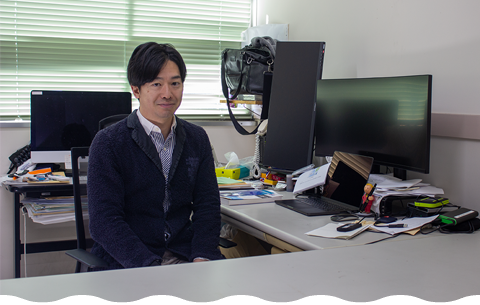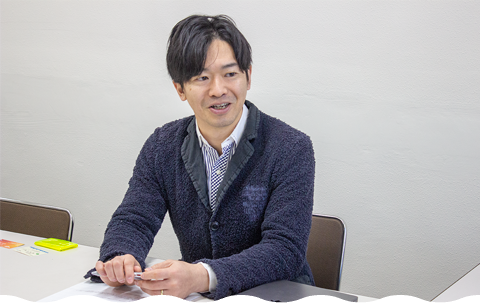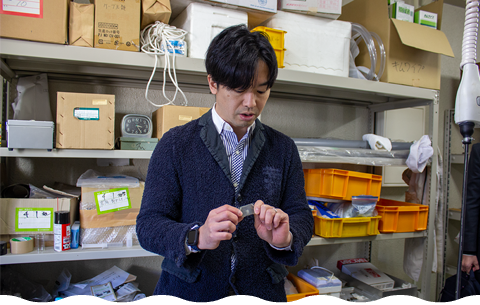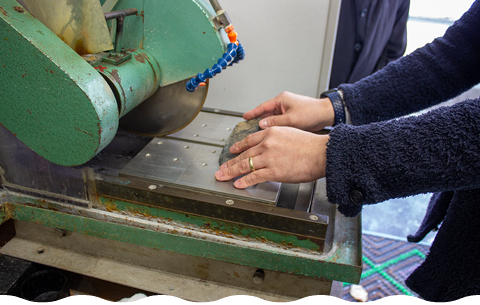
A. I am interested in the past environment of the Earth and geology, so at university, I majored in Earth Science at the School of Science. For my graduation thesis, I conducted research on limestone rocks in Akiyoshidai, Yamaguchi Prefecture. That is the starting point of my research. After continuing on to graduate school, I wanted to study an even older period, so I conducted research on rocks and oceans from the Ediacaran period, about 600 million years ago. I then went to work at the National Institute of Advanced Industrial Science and Technology (AIST) in Tsukuba City, Ibaraki Prefecture. There I began to undertake full-scale research on marine geology, and in 2018, I moved to Tokyo University of Marine Science and Technology because of my background in marine geology. Today, while conducting research on marine geology at the Tokyo University of Marine Science and Technology, I also continue to work on research on past marine environments focusing on rocks on land, which I have been doing since I was a student.
A. Marine geology is the study of how geological features developed in the ocean. Carbonate sedimentology studies where and how carbonate sediments originating from coral reefs accumulate. Knowledge of marine geology is essential to understanding the development process of the places where carbonate sediments accumulate, and the two disciplines are closely related.
A. Limestone, a typical rock formed by carbonate, is formed through the accumulation of corals and other organisms from the past and contains information about the marine environment at that time. I have been interested in researching the conditions of the past marine environment and the global environment through such limestone since high school. When I entered university, I wanted to study in an environment where I could not only conduct full-scale research, but also have the opportunity to have experiences unique as a university student. As a result, I was attracted to Okinawa, which is characterized by islands formed by coral reefs, and chose the University of the Ryukyus. Okinawa is a very interesting field for studying carbonate sedimentology, and I feel that I have gained many findings and experiences through my research there.

A. In marine geology, my research focuses on the geology of the open ocean and coastal areas. I am very interested in understanding how the geology of the region where I live and the field I study formed, so my research mainly focuses on the coastal zone. In the coastal zone, the geological condition of the land continues to the sea, and by studying the sea, we can understand the geological formation and development of the land in more detail and in more concrete terms. Furthermore, we are also conducting geological studies in the open ocean at the same time. Specifically, to understand how the entire Ryukyu Arc, including Okinawa, has developed, we are using seismic reflection surveys to examine the strata beneath the seafloor. This technique allows for a detailed understanding of the geological development process. Carbonate sedimentology, on the other hand, involves collecting carbonate rocks such as limestone and dolomite from strata to study the marine environment of the time. I am particularly interested in the period known as the Ediacaran period. This is the period just before the “Cambrian Explosion” (about 540 million years ago), when organisms evolved exponentially. The Cambrian Explosion saw a rapid increase in the number of animals with chordates, and it is important to investigate the Ediacaran marine environment, the period just prior to the Cambrian Explosion, in order to understand why this evolution took place.
 (At the conference room of Tokyo University of Marine Science
and Technology)
(At the conference room of Tokyo University of Marine Science
and Technology)
A. My lectures mainly cover marine geology and its research methods, and I teach students how to collect data and conduct surveys. In addition, several faculty members share the responsibility of teaching general geology to first- and second-year undergraduate students, and I teach the students about the types of rocks and the sedimentary processes of sediment particles such as sand and mud. Through my lectures, I try to help students develop a basic understanding of geology.

A. I started to think about Okinotorishima island as my research topic when I found out that the Tokyo Metropolitan Government was conducting a research study on Okinotorishima island. In the process of researching Okinotorishima island, I noticed that Akiyoshidai in Yamaguchi Prefecture, where I have been conducting my research, and Okinotorishima island share the same geological features, and also because my interest in Okinotorishima island had grown stronger, I decided to apply for the open call.


A. We are integrating geophysical observation data in the sea area around Okinotorishima island with the aim of characterizing the submarine topography of Okinotorishima island and its surrounding waters. In a typical oceanographic survey, the target field is generally surveyed systematically and in detail, but in the integration of geophysical observation data, we have adopted a method of accumulating data that has been continuously acquired since the ship was launched and combining them into one. In this research study, data released by JAMSTEC (Japan Agency for Marine-Earth Science and Technology), as well as past data gathered by AIST and other organizations, are collected, integrated, and organized.
 (MINERAFRONT, The Museum of Mineral Resources Frontier, Faculty
of Engineering, The University of Tokyo)
(MINERAFRONT, The Museum of Mineral Resources Frontier, Faculty
of Engineering, The University of Tokyo)
A. By uncovering the structure beneath the seafloor, we expect to learn about the details of how the seamounts that form Okinotorishima island have developed. Okinotorishima island is located on a part of a ridge called the Kyushu-Palau Ridge, but the formation process of this ridge itself is broadly understood. It is believed that the Kyushu-Palau Ridge was formed away from the Izu-Ogasawara Ridge, and that the seamount of Okinotorishima island formed within the Kyushu-Palau Ridge. However, the details of when the seamounts comprising Okinotorishima island were formed and how they developed are still unknown. We hope to clarify the details of the formation history of Okinotorishima island through this research study.
A. Many people have heard of Okinotorishima island, but not many know what kind of island it is. I myself first started to look into Okinotorishima island in depth by chance, because of the opportunity to do research. Since the research study began this year, there has been an increase in the number of students expressing a desire to visit Okinotorishima island and showing interest in the island, particularly when they are assigned to a laboratory in their third year of university. This made me realize again that having the appropriate opportunity is important to generate interest in Okinotorishima island. I will try to inform students about the charms of Okinotorishima island through my lectures. I have heard that the Tokyo Metropolitan Government is also making efforts to promote interest in Okinotorishima island, by providing information on its website, holding PR events, and so on. I believe that the first important step in maintaining, preserving, and utilizing Okinotorishima island is to get people interested in the island. Therefore, I would be happy if more people experienced Okinotorishima island and became aware of its charm and importance so that they could discover and learn more about it.